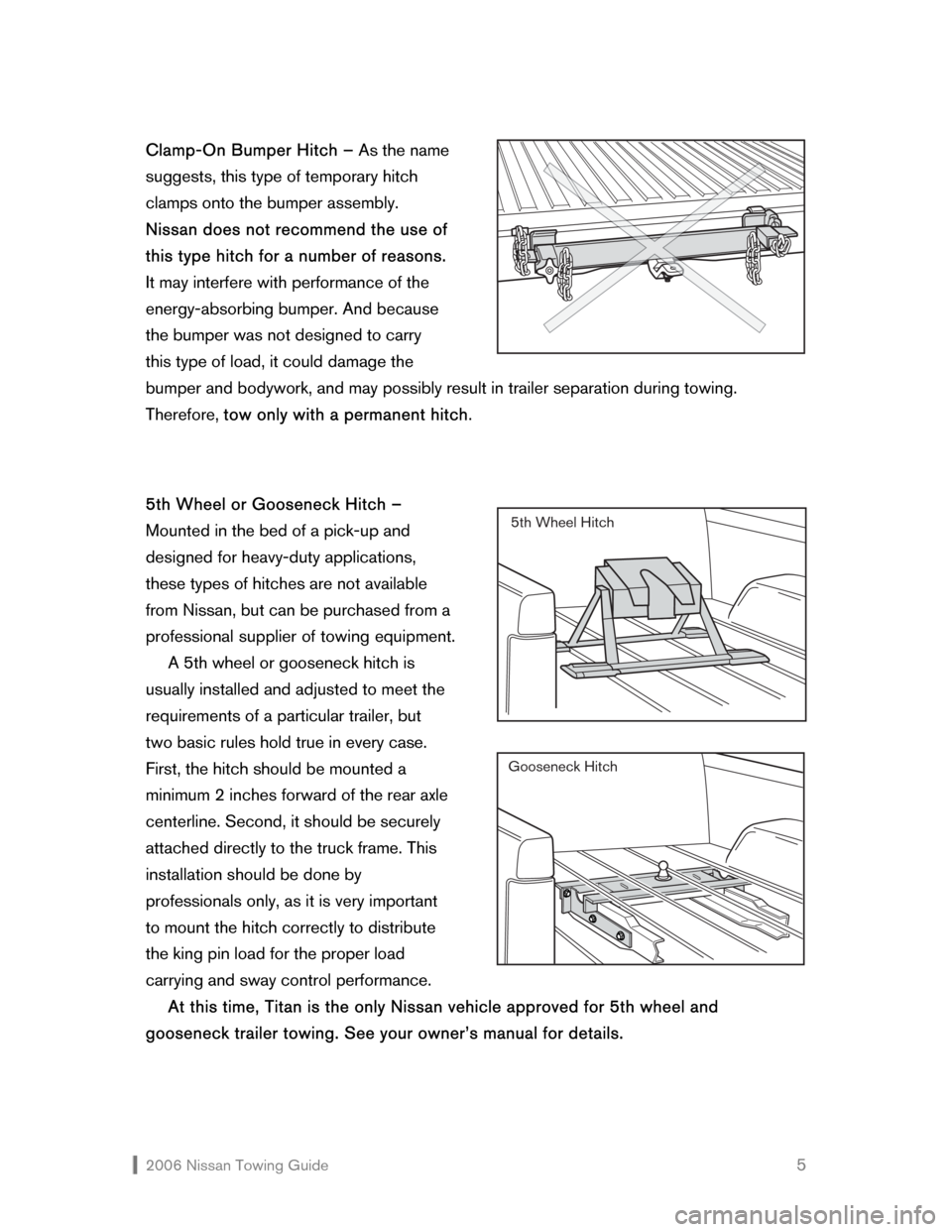2006 NISSAN MAXIMA ECU
[x] Cancel search: ECUPage 4 of 28

2006 Nissan Towing Guide 3 If you are buying a travel or boat trailer, be sure that your Nissan vehicle has the towing
capacity to pull it. See the SPECIFICATIONS section of this guide, or refer to your owner’s
manual for detailed information regarding the towing capacity of your specific vehicle. Your
owner’s manual should ALWAYS be referenced before making any towing decisions.
Naturally, you’ll want to buy the highest-quality equipment you can find for maximum
towing safety. And if you plan to tow often, consider convenience. Quick-disconnect trailer
light connectors and ratchet-type tie-downs, for example, make the job go faster and easier,
and are usually worth the small extra investment.
WHAT’S
RIGHT FOR YOU
TYPES OF EQUIPMENT
Towing requires a variety of equipment, and, depending upon the application, there can be
several types or styles of each piece of equipment. Working with your Nissan dealer or a
professional supplier of towing equipment, it should be relatively simple to determine the
proper type of equipment for your specific vehicle given the intended application. This
section explains the most common pieces of towing equipment available.
HITCHES
Whichever type of hitch you use, it should be firmly bolted to your vehicle, and should be of
the appropriate weight class for the equipment you intend to tow. In addition, keep the
following in mind:
�Š Do not modify the vehicle’s braking or exhaust systems or its body structure/frame when
installing the hitch.
�Š Be sure that the hitch does not interfere in any way with the vehicle’s energy-absorbing
bumper.
�Š Regularly check to see that all hitch-mounting bolts are securely fastened.
�Š Where practical, remove the hitch when not in use. Your Nissan dealer can assist you in
hitch removal and reinstallation. When removed, seal the bolt holes to prevent road
spray, fumes, water, and dirt from entering the vehicle.
�Š For receiver-type hitches using a ball mount, the ball mount should be removed when
not towing.
�Š If you install a hitch yourself, remember that it must be securely attached to the frame or
underbody, according to the manufacturer’s instructions. Never attach a hitch or
towing device to the vehicle axle housing. This may damage the housing, wheel
bearings, wheels, or tires.
Page 6 of 28

2006 Nissan Towing Guide 5 Clamp-On Bumper Hitch – As the name
suggests, this type of temporary hitch
clamps onto the bumper assembly.
Nissan does not recommend the use of
this type hitch for a number of reasons.
It may interfere with performance of the
energy-absorbing bumper. And because
the bumper was not designed to carry
this type of load, it could damage the
bumper and bodywork, and may possibly result in trailer separation during towing.
Therefore, tow only with a permanent hitch.
5th Wheel or Gooseneck Hitch –
Mounted in the bed of a pick-up and
designed for heavy-duty applications,
these types of hitches are not available
from Nissan, but can be purchased from a
professional supplier of towing equipment.
A 5th wheel or gooseneck hitch is
usually installed and adjusted to meet the
requirements of a particular trailer, but
two basic rules hold true in every case.
First, the hitch should be mounted a
minimum 2 inches forward of the rear axle
centerline. Second, it should be securely
attached directly to the truck frame. This
installation should be done by
professionals only, as it is very important
to mount the hitch correctly to distribute
the king pin load for the proper load
carrying and sway control performance.
At this time, Titan is the only Nissan vehicle approved for 5th wheel and
gooseneck trailer towing. See your owner’s manual for details.
5th Wheel Hitch
Gooseneck Hitch
Page 16 of 28

2006 Nissan Towing Guide 15 With this in mind, proper loading is
extremely important. When loading a trailer,
60% of the total cargo weight should be
positioned in the front portion of the trailer
and 40% in the back. Then, the load should
be adjusted until the proper tongue/king pin
load ratio is achieved.
The trailer load should be balanced
equally from side-to-side. Unequal side-to-
side loading can negatively affect handling
and braking. Once in place, all cargo should
be firmly secured to prevent shifting. If the
load should shift abruptly during braking or
cornering, it could quickly affect the
handling of your vehicle and cause a very
unsafe situation.
Finally, do not carry flammable materials,
such as gasoline, in your trailer. In the event
of an accident, an explosion or fire could
occur.
ENSURING VEHICLE/TRAILER STABILITY
Improper loading, excessive or insufficient trailer tongue/king pin load, overloading,
excessive trailer weight, poorly designed trailer suspensions, crosswinds, and poor
maintenance are all things that can affect the stability of your vehicle/trailer combination.
If swaying does occur, check the cargo load for proper balance and distribution to
ensure proper trailer tongue/king pin load. In addition, check the condition of the
suspension and shocks, as well as the tires, tire pressures, and wheel bearings on both the
tow vehicle and the trailer. If swaying occurs because of high winds or poor weather
conditions, wait until these conditions improve before resuming your trip.
If the swaying continues and you feel your trailer is suitably balanced and within the
towing capacity limits of your vehicle, discontinue towing and consult your Nissan dealer or
trailer manufacturer to determine the problem. Most important, do not tow until the problem
is corrected.
Page 17 of 28

2006 Nissan Towing Guide 16 VEHICLE SPEED
Some states have specific regulations and speed limits for vehicles that are towing trailers.
Always obey these ordinances. Remember to reduce your speed in unsafe or less-than-
ideal road conditions or weather. When towing a trailer, braking distances increase while
handling agility decreases. Always leave yourself an extra margin of distance to respond to
emergency situations.
PASSENGERS
Never allow passengers to ride inside a trailer while it is being towed. Not only is this
unlawful in most areas, passengers could be seriously injured during sudden trailer
movement or in an accident. In addition, trailers may allow fumes from the tow vehicle to
leak inside. This could result in carbon monoxide poisoning from the engine exhaust.
VEHICLE MODIFICATIONS
Vehicle modifications — beyond those required for proper hitch installation, wiring hook-up,
and necessary cooling system upgrading — are not recommended for any Nissan vehicle
being used for towing purposes. Changes to the drivetrain, suspension, exhaust systems,
frame structure/unibody, or other vehicle components are not necessary for towing within
the limits described in this guide. These changes may diminish the reliability and longevity
of your vehicle and possibly void warranty coverage as well.
TOOL KIT
It is always a good idea to travel with a special tool kit when towing. In addition to tools, it
should contain flares, a flashlight, emergency reflectors, jumper cables, extra fuses, extra
radiator coolant, oil, and easily replaced spare parts such as taillight bulbs. You should also
carry spare tires for your tow vehicle and trailer, as well as a jack suitable for use on the
trailer. Be aware that not all automotive jacks can be used safely on a trailer.
BEFORE STARTING OUT
Before starting out on a trip, make one last inspection of the tow vehicle and the trailer. Are
the tire pressures correct? Are the safety chains/cables securely in place? Is the cargo tied
down securely? Do all the lights work? Is the coupler properly attached over the hitch ball
and secured using a locking pin? Is the breakaway switch hooked up and functioning
properly? Are vehicle and electric trailer brakes working properly?
Make a checklist of key items to be inspected, and don’t forget the basics. When
towing, vehicle engine oil, transmission oil, and coolant should always be checked before
starting out. Finding a potential problem while in your driveway is better than discovering it
miles from home.
Page 27 of 28

2006 Nissan Towing Guide 26
PROTECTION
At Nissan, we back everything we build. So we’re proud that every Nissan is protected by
some of the best New Vehicle Limited Warranties, including 36-month/36,000-mile basic
coverage. All 2006 models also feature 60-month/60,000-mile powertrain coverage.* And,
Nissan warranties are completely transferable if you should sell your Nissan.
If you want additional peace of mind, we proudly offer the Nissan Security+Plus
®
Vehicle Protection Plan. This plan offers quality mechanical protection long after your New
Vehicle Limited Warranty expires.
The Security+Plus
® Vehicle Protection Plan is backed by Nissan and designed
exclusively for Nissan owners. From a variety of plans available, you can choose the one
that best fits your driving needs (up to 84 months/100,000 miles!). For the maximum
coverage, you’ll want to opt for Security+Plus Gold Preferred.
Whichever plan you choose, coverage is available throughout the United States. Repair
work will be done at authorized Nissan dealers by Nissan-trained technicians utilizing
Genuine Nissan Parts.
For more information about Security+Plus
® Vehicle Protection Plans, contact your
participating Nissan dealer.
The quality of Genuine Nissan Parts and Accessories is backed by the integrity of a
Genuine Nissan Replacement Parts and Accessories Limited Warranty. If purchased within
the basic coverage period of 36 months/36,000 miles, Genuine Nissan Parts and
Accessories are covered by the remaining period of the warranty. If the remaining period is
less than 12 months/12,000 miles (or if the vehicle warranty has expired), then Genuine
Nissan Accessories are covered by their own 12-month/12,000-mile Limited Warranty.
See your Warranty Information Booklet or ask your Nissan dealer for specific details.
CONCERN FOR YOUR SAFETY
Nissan urges you to always use your seat belt whenever you drive. And please make sure
all passengers are buckled up. Keep in mind that air bags are a supplemental restraint
system and must always be used in conjunction with a seat belt.
Also, with a front passenger air bag, a rear-facing child restraint must never be placed
in the front passenger's seat. Children 12 and under should ride in the rear seat properly
secured in child restraints, booster seats, or seat belts, according to their size. Please see
your owner's manual for more details.
*For complete warranty details, read the Warranty Information Booklet or see your nearest Nissan
dealer.